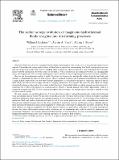Files in this item
The sulfur isotope evolution of magmatic-hydrothermal fluids : insights into ore-forming processes
Item metadata
| dc.contributor.author | Hutchison, William | |
| dc.contributor.author | Finch, Adrian A. | |
| dc.contributor.author | Boyce, Adrian J. | |
| dc.date.accessioned | 2020-09-04T14:30:04Z | |
| dc.date.available | 2020-09-04T14:30:04Z | |
| dc.date.issued | 2020-11-01 | |
| dc.identifier | 269646981 | |
| dc.identifier | 5b71112f-8ee4-4f00-95f9-511ecd933c4d | |
| dc.identifier | 85090008299 | |
| dc.identifier | 000574850100011 | |
| dc.identifier.citation | Hutchison , W , Finch , A A & Boyce , A J 2020 , ' The sulfur isotope evolution of magmatic-hydrothermal fluids : insights into ore-forming processes ' , Geochimica et Cosmochimica Acta , vol. 288 , pp. 176-198 . https://doi.org/10.1016/j.gca.2020.07.042 | en |
| dc.identifier.issn | 0016-7037 | |
| dc.identifier.other | RIS: urn:E349EF5C972694C25BD4890644C7AB28 | |
| dc.identifier.other | ORCID: /0000-0002-3689-1517/work/79226695 | |
| dc.identifier.uri | https://hdl.handle.net/10023/20547 | |
| dc.description | This project was supported by the European Union’s Horizon 2020 research and innovation programme under grant agreement No. 689909. W.H. also acknowledges support from a UKRI Future Leaders Fellowship (MR/S033505/1). A.J.B. is funded by the NERC National Environment Isotope Facility award (NE/S011587/1) and the Scottish Universities Environmental Research Centre. | en |
| dc.description.abstract | Metal-rich fluids that circulate in magmatic-hydrothermal environments form a wide array of economically significant ore deposits. Unravelling the origins and evolution of these fluids is crucial for understanding how Earth’s metal resources form and one of the most widely used tools for tracking these processes is sulfur isotopes. It is well established that S isotopes record valuable information about the source of the fluid, as well as its physical and chemical evolution (i.e. changing pH, redox and temperature), but it is often challenging to unravel which of these competing processes drives isotopic variability. Here we use thermodynamic models to predict S isotope fractionation for geologically realistic hydrothermal fluids and attempt to disentangle the effects of fluid sources, physico-chemical evolution and S mineral disequilibrium. By modelling a range of fluid compositions, we show that S isotope fingerprints are controlled by the ratio of oxidised to reduced S species (SO42−/H2S), and this is most strongly affected by changing temperature, fO2 and pH. We show that SO42−/H2S can change dramatically during cooling and our key insight is that S isotopes of individual sulfide or sulfate minerals can show large fractionations (up to 20 ‰) even when pH is constant and fO2 fixed to a specific mineral redox buffer. Importantly, while it is commonly assumed that SO42−/H2S is constant throughout fluid evolution, our analysis shows that this is unlikely to hold for most natural systems. We then compare our model predictions to S isotope data from porphyry and epithermal deposits, seafloor hydrothermal vents and alkaline igneous bodies. We find that our models accurately reproduce the S isotope evolution of porphyry and high sulfidation epithermal fluids, and that most require magmatic S sources between 0 and 5 ‰. The S isotopes of low sulfidation epithermal fluids and seafloor hydrothermal vents do not fit our model predictions and reflect disequilibrium between the reduced and oxidised S species and, for the latter, significant S input from seawater and biogenic sources. Alkaline igneous fluids match model predictions and confirm magmatic S sources and a wide range of temperature and redox conditions. Of all these different ore deposits, porphyry and alkaline igneous systems are particularly well-suited to S isotope investigation because they show relationships between redox, alteration and ore mineralogy that could be useful for exploration and prospecting. Ultimately, our examples demonstrate that S isotope forward models are powerful tools for identifying S sources, flagging disequilibrium processes, and validating hypotheses of magmatic fluid evolution. | |
| dc.format.extent | 3854817 | |
| dc.language.iso | eng | |
| dc.relation.ispartof | Geochimica et Cosmochimica Acta | en |
| dc.subject | Sulfur isotopes | en |
| dc.subject | Hydrothermal fluid | en |
| dc.subject | Porphyry | en |
| dc.subject | Epithermal | en |
| dc.subject | Seafloor hydrothermal | en |
| dc.subject | Alkaline igneous | en |
| dc.subject | Ore deposits | en |
| dc.subject | GE Environmental Sciences | en |
| dc.subject | DAS | en |
| dc.subject.lcc | GE | en |
| dc.title | The sulfur isotope evolution of magmatic-hydrothermal fluids : insights into ore-forming processes | en |
| dc.type | Journal article | en |
| dc.contributor.sponsor | Medical Research Council | en |
| dc.contributor.sponsor | European Commission | en |
| dc.contributor.institution | University of St Andrews. School of Earth & Environmental Sciences | en |
| dc.contributor.institution | University of St Andrews. Scottish Oceans Institute | en |
| dc.contributor.institution | University of St Andrews. St Andrews Isotope Geochemistry | en |
| dc.identifier.doi | https://doi.org/10.1016/j.gca.2020.07.042 | |
| dc.description.status | Peer reviewed | en |
| dc.identifier.grantnumber | MR/S033505/1 | en |
| dc.identifier.grantnumber | 689909 | en |
This item appears in the following Collection(s)
Items in the St Andrews Research Repository are protected by copyright, with all rights reserved, unless otherwise indicated.

